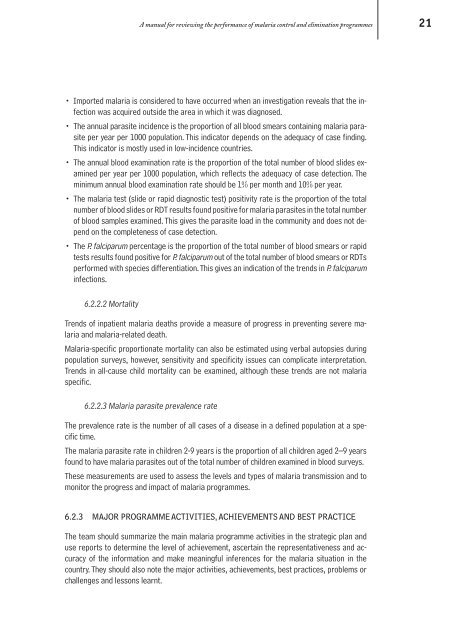Malaria programme reviews: - World Health Organization
Malaria programme reviews: - World Health Organization
Malaria programme reviews: - World Health Organization
Create successful ePaper yourself
Turn your PDF publications into a flip-book with our unique Google optimized e-Paper software.
A manual for reviewing the performance of malaria control and elimination <strong>programme</strong>s 21<br />
• Imported malaria is considered to have occurred when an investigation reveals that the infection<br />
was acquired outside the area in which it was diagnosed.<br />
• The annual parasite incidence is the proportion of all blood smears containing malaria parasite<br />
per year per 1000 population. This indicator depends on the adequacy of case finding.<br />
This indicator is mostly used in low-incidence countries.<br />
• The annual blood examination rate is the proportion of the total number of blood slides examined<br />
per year per 1000 population, which reflects the adequacy of case detection. The<br />
minimum annual blood examination rate should be 1% per month and 10% per year.<br />
• The malaria test (slide or rapid diagnostic test) positivity rate is the proportion of the total<br />
number of blood slides or RDT results found positive for malaria parasites in the total number<br />
of blood samples examined. This gives the parasite load in the community and does not depend<br />
on the completeness of case detection.<br />
• The P. falciparum percentage is the proportion of the total number of blood smears or rapid<br />
tests results found positive for P. falciparum out of the total number of blood smears or RDTs<br />
performed with species differentiation. This gives an indication of the trends in P. falciparum<br />
infections.<br />
6.2.2.2 Mortality<br />
Trends of inpatient malaria deaths provide a measure of progress in preventing severe malaria<br />
and malaria-related death.<br />
<strong>Malaria</strong>-specific proportionate mortality can also be estimated using verbal autopsies during<br />
population surveys, however, sensitivity and specificity issues can complicate interpretation.<br />
Trends in all-cause child mortality can be examined, although these trends are not malaria<br />
specific.<br />
6.2.2.3 <strong>Malaria</strong> parasite prevalence rate<br />
The prevalence rate is the number of all cases of a disease in a defined population at a specific<br />
time.<br />
The malaria parasite rate in children 2-9 years is the proportion of all children aged 2–9 years<br />
found to have malaria parasites out of the total number of children examined in blood surveys.<br />
These measurements are used to assess the levels and types of malaria transmission and to<br />
monitor the progress and impact of malaria <strong>programme</strong>s.<br />
6.2.3 majoR PRogRamme activities, achievements and best PRactice<br />
The team should summarize the main malaria <strong>programme</strong> activities in the strategic plan and<br />
use reports to determine the level of achievement, ascertain the representativeness and accuracy<br />
of the information and make meaningful inferences for the malaria situation in the<br />
country. They should also note the major activities, achievements, best practices, problems or<br />
challenges and lessons learnt.

















